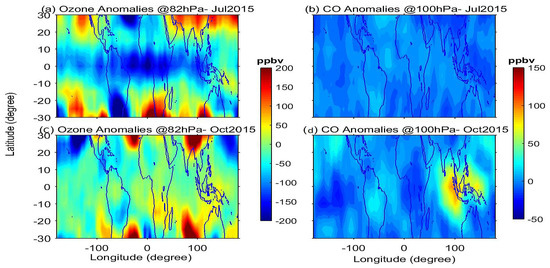Large Anomalies in the Tropical Upper Troposphere Lower Stratosphere (UTLS) Trace Gases Observed during the Extreme 2015–16 El Niño Event by Using Satellite Measurements
Abstract
1. Introduction
2. Data base and Methodology
2.1. MLS Data
2.2. Atmosphere Infrared Radio Souder Data
2.3. COSMIC GPS RO Data
3. Results and Discussion
3.1. Unusual Behaviour of Trace Gases in the Tropical UTLS Region during the 2015–16 El Niño Event
3.2. Spatial Distributions of Trace Gas Anomalies during the 2015–16 El Niño Event
3.3. Spatial Variability of Cold Point Tropopause Temperature during December 2015
3.4. Water Vapour Changes during the 2015–16 El Nino
4. Summary and Conclusions
- (1)
- A 32% (23%) decrease in the zonal mean equatorial O3 is observed at 100 hPa (82 hPa) in July (August) 2015 and decrease in the O3 is recorded maximum in the recent decade.
- (2)
- A 38% (25%) increase of the zonal mean equatorial CO is observed at 146 hPa (100 hPa) in November 2015. The observed increased changes in the CO concentrations are recorded maximum in the MLS data period. The carbon emissions observed over SEA and WP regions play a crucial role on the increased high zonal mean CO in 2015–16 El Nino period.
- (3)
- Large anomalies of cold point tropopause temperatures (5 K) are noticed from the COSMIC GPS RO observations over SEA and WP regions in December 2015.
- (4)
- A 26% (20%) increase of the zonal mean equatorial WV is found at 82 hPa (100 hPa) in December 2015 whereas a ~30% WV decrease is observed in 2016.
Author Contributions
Funding
Acknowledgments
Conflicts of Interest
References
- Shepherd, T.G. Transport in the middle atmosphere. Meteorol. Soc. Jpn. II 2007, 85B, 165–191. [Google Scholar] [CrossRef]
- Forster, P.M.; Shine, K.P. Stratospheric water vapour changes as a possible contributor to observed stratospheric cooling. Geophys. Res. Lett. 1999, 26, 3309–3312. [Google Scholar] [CrossRef]
- Forster, P.; Ramaswamy, V.; Artaxo, P.; Berntsen, T.; Betts, R.; Fahey, D.W.; Haywood, J.; Lean, J.; Lowe, D.C.; Myhre, G.; et al. Radiative Forcing of Climate Change. In Climate Change 2007: The Physical Science Basis. Contribution of Working Group I to the Fourth Assessment Report of the Intergovernmental Panel on Climate Change; Cambridge University Press: Cambridge, UK, 2007; pp. 129–234. [Google Scholar]
- Solomon, S.; Rosenlof, K.H.; Portmann, R.W.; Daniel, J.S.; Davis, S.M.; Sanford, T.; Plattner, G.-K. Contributions of Stratospheric Water Vapor to Decadal Changes in the Rate of Global Warming. Science 2010, 327, 1219–1223. [Google Scholar] [CrossRef]
- Maycock, A.C.; Shine, K.P.; Joshi, M.M. The temperature response to stratospheric water vapour changes. Q. J. R. Meteorol. Soc. 2011, 137, 1070–1082. [Google Scholar] [CrossRef]
- Riese, M.; Ploeger, F.; Rap, A.; Vogel, B.; Konopka, P.; Dameris, M.; Forster, P. Impact of uncertainties in atmospheric mixing on simulated UTLS composition and related radiative effects. J. Geophys. Res. 2012, 117, D16305. [Google Scholar] [CrossRef]
- Avery, M.A.; Davis, S.M.; Rosenlof, K.H.; Ye, H.; Dessler, A.E. Large anomalies in lower stratospheric water vapour and ice during the 2015–2016 El Niño. Nat. Geosci. 2017. [Google Scholar] [CrossRef]
- Domeisen, D.I.; Garfinkel, C.I.; Butler, A.H. The teleconnection of El Niño Southern Oscillation to the stratosphere. Rev. Geophys. 2019, 57. [Google Scholar] [CrossRef]
- Diallo, M.; Riese, M.; Birner, T.; Konopka, P.; Müller, R.; Hegglin, M.I.; Santee, M.L.; Baldwin, M.; Legras, B.; Ploeger, F. Response of stratospheric water vapor and ozone to the unusual timing of El Niño and the QBO disruption in 2015–2016. Atmos. Chem. Phys. 2018, 18, 13055–13073. [Google Scholar] [CrossRef]
- Randel, W.J.; Garcia, R.R.; Calvo, N.; Marsh, D. ENSO influence on zonal mean temperature and ozone in the tropical lower stratosphere. Geophys. Res. Lett. 2009, 39. [Google Scholar] [CrossRef]
- Diallo, M.; Konopka, P.; Santee, M.L.; Müller, R.; Tao, M.; Walker, K.A.; Legras, B.; Riese, M.; Ern, M.; Ploeger, F. Structural changes in the shallow and transition branch of the Brewer–Dobson circulation induced by El Niño. Atmos. Chem. Phys. 2109, 19, 425–446. [Google Scholar] [CrossRef]
- Nassar, R.; Logan, J.A.; Megretskaia, I.A.; Murray, L.T.; Zhang, L.; Jones, D.B.A. Analysis of tropical tropospheric ozone, carbon monoxide and water vapor during the 2006 El Niño using TES observations and the GEOS-Chem model. J. Geophys. Res. 2009, 114, D17304. [Google Scholar] [CrossRef]
- Logan, J.A.; Megretskaia, I.; Nassar, R.; Murray, L.T.; Zhang, L.; Bowman, K.W.; Worden, H.M.; Luo, M. Effects of the 2006 El Niño on tropospheric composition as revealed by data from the Tropospheric Emission Spectrometer (TES). Geophys. Res. Lett. 2008, 35, L03816. [Google Scholar] [CrossRef]
- Chandra, S.; Ziemke, J.R.; Duncan, B.N.; Diehl, T.L.; Livesey, N.J.; Froidevaux, L. Effects of the 2006 El Niño on tropospheric ozone and carbon monoxide: Implications for dynamics and biomass burning. Atmos. Chem. Phys. 2009, 9, 4239–4249. [Google Scholar] [CrossRef]
- Chandra, S.; Ziemke, J.R.; Schoeberl, M.R.; Froidevaux, L.; Read, W.G.; Levelt, P.F.; Bhartia, P.K. Effects of the 2004 El Niño on tropospheric ozone and water vapour. Geophys. Res. Lett. 2007, 34, L06802. [Google Scholar] [CrossRef]
- Doherty, R.M.; Stevenson, D.S.; Johnson, C.E.; Collins, W.J.; Sanderson, M.G. Tropospheric ozone and El Niño–Southern Oscillation: Influence of atmospheric dynamics, biomass burning emissions and future climate change. J. Geophys. Res. 2006, 111, D19304. [Google Scholar] [CrossRef]
- Tweedy, O.V.; Waugh, D.W.; Randel, W.J.; Abalos, M.; Oman, L.D.; Kinnison, D.E. The impact of boreal summer ENSO events on tropical lower stratospheric ozone. J. Geophys. Res. Atmos. 2018, 123, 9843–9857. [Google Scholar] [CrossRef]
- Huijnen, V.; Wooster, M.; Kaiser, J.; Gaveau, D.; Flemming, J.; Parrington, M.; Inness, A.; Murdiyarso, D.; Main, B.; van Weele, M. Fire Carbon Emissions Over Maritime Southeast Asia in 2015 Largest Since 1997. Sci. Rep. 2016, 6, 26886. [Google Scholar] [CrossRef]
- Field, R.D.; van der Werf, G.R.; Fanin, T.; Fetzer, E.J.; Fuller, R.; Jethva, H.; Levy, R.; Livesey, N.J.; Luo, M.; Torres, O.; et al. Indonesian fire activity and smoke pollution in 2015 show persistent nonlinear sensitivity to El Niño induced drought. Proc. Natl. Acad. Sci. USA 2016, 113, 9204–9209. [Google Scholar] [CrossRef]
- Heymann, J.; Reuter, M.; Buchwitz, M.; Schneising, O.; Bovensmann, H.; Burrows, J.P.; Massart, S.; Kaiser, J.W.; Crisp, D. CO2 emission of Indonesian fires in 2015 estimated from satellite-derived atmospheric CO2 concentrations. Geophys. Res. Lett. 2017. [Google Scholar] [CrossRef]
- Parker, R.J.; Boesch, H.; Wooster, M.J.; Moore, D.P.; Webb, A.J.; Gaveau, D.; Murdiyarso, D. Atmospheric CH4 and CO2 enhancements and biomass burning emission ratios derived from satellite observations of the 2015 Indonesian fire plumes. Atmos. Chem. Phys. 2016, 16, 10111–10131. [Google Scholar] [CrossRef]
- Whitburn, S.; Van Damme, M.; Clarisse, L.; Turquety, S.; Clerbaux, C.; Coheur, P.F. Doubling of Annual Ammonia Emissions from the Peat Fires in Indonesia During the 2015 El Niño. Geophys. Res. Lett. 2016, 43, 11007–11014. [Google Scholar] [CrossRef]
- Osprey, S.M.; Butchart, N.; Knight, J.R.; Scaife, A.A.; Hamilton, K.; Anstey, J.A.; Schenzinger, V.; Zhang, C. An unexpected disruption of the atmospheric quasi-biennial oscillation. Science 2016, 353, 1424–1427. [Google Scholar] [CrossRef]
- Coy, L.; Newman, P.; Pawson, S.; Lait, L.R. Dynamics of the disrupted 2015–16 quasi-biennial oscillation. J. Clim. 2017, 30, 5661–5674. [Google Scholar] [CrossRef]
- Tweedy, O.V.; Kramarova, N.A.; Strahan, S.E.; Newman, P.A.; Coy, L.; Randel, W.J.; Park, M.; Waugh, D.W.; Frith, S.M. Response of trace gases to the disrupted 2015–2016 quasi-biennial oscillation. Atmos. Chem. Phys. 2017, 17, 6813–6823. [Google Scholar] [CrossRef]
- Garfinkel, C.I.; Gordon, A.; Oman, L.D.; Li, F.; Davis, S.; Pawson, S. Nonlinear response of tropical lower-stratospheric temperature and water vapor to ENSO. Atmos. Chem. Phys. 2018, 18, 4597–4615. [Google Scholar] [CrossRef]
- Garfinkel, C.I.; Hurwitz, M.M.; Oman, L.D.; Waugh, D.W. Contrasting effects of Central Pacific and Eastern Pacific El Niño on stratospheric water vapor. Geophys. Res. Lett. 2013, 40, 4115–4120. [Google Scholar] [CrossRef]
- Fueglistaler, S.; Dessler, A.E.; Dunkerton, T.J.; Folkins, I.; Fu, Q.; Mote, P.W. Tropical Tropopause Layer. Rev. Geophys. 2009, 47, G1004. [Google Scholar] [CrossRef]
- Randel, W.J.; Jensen, E.J. Physical processes in the tropical tropopause layer and their roles in a changing climate. Nat. Geosci. 2013, 6, 169–176. [Google Scholar] [CrossRef]
- Ravindra Babu, S.; Venkat Ratnam, M.; Basha, G.; Krishnamurthy, B.V. Indian summer monsoon onset signatures on the tropical tropopause layer. Atmos. Sci. Lett. 2019, e884. [Google Scholar] [CrossRef]
- Gettelman, A.; Forster, P.; Fujiwara, M.; Fu, Q.; Vomel, H.; Gohar, L.; Johason, C.; Ammerman, M. The radiation balance of the tropical tropopause layer. J. Geophys. Res. 2004, 109, D07103. [Google Scholar] [CrossRef]
- Oman, L.D.; Douglass, A.R.; Ziemke, J.R.; Rodriguez, J.M.; Waugh, D.W.; Nielsen, J.E. The ozone response to ENSO in Aura satellite measurements and a chemistry climate model. J. Geophys. Res. 2013, 118, 965976. [Google Scholar] [CrossRef]
- Lelieveld, J.; Gromov, S.; Pozzer, A.; Taraborrelli, D. Global tropospheric hydroxyl distribution, budget and reactivity. Atmos. Chem. Phys. 2016, 16, 12477–12493. [Google Scholar] [CrossRef]
- Wolter, K.; Timlin, M.S. Measuring the strength of ENSO events—How does 1997/98 rank? Weather 1998, 53, 315–324. [Google Scholar] [CrossRef]
- Wolter, K.; Timlin, M.S. El Nino/Southern Oscillation behavior since 1871 as diagnosed in an extended multivariate ENSO index (MEI. ext). Int. J. Climatol 2011, 31, 1074–1087. [Google Scholar] [CrossRef]
- Livesey, N.J.; Read, W.G.; Wagner, P.A.; Froidevaux, L.; Lambert, A.; Manney, G.L.; Pumphrey, H.C.; Santee, M.L.; Schwartz, M.J.; Wang, S.; et al. Aura Microwave Limb Sounder (MLS) Version 4.2× Level 2 Data Quality and Description Document; JPL D-33509 Rev.D, Tech. Rep.; NASA Jet Propulsion Laboratory, California Institute of Technology: Pasadena, CA, USA, 2018. [Google Scholar]
- Anthes, R.A.; Bernhardt, P.A.; Chen, Y.; Cucurull, L.; Dymond, K.F.; Ector, D.; Healy, S.B.; Ho, S.P.; Hunt, D.C.; Kuo, Y.H.; et al. The COSMIC/Formosat/3 mission: Early results. Bull. Am. Meteorol. Soc. 2008, 89, 313–333. [Google Scholar] [CrossRef]
- Rao, D.N.; Ratnam, M.V.; Mehta, S.; Nath, D.; Ghouse Basha, S.; Jagannadha Rao, V.V.M.; Krishna Murthy, B.V.; Tsuda, T.; Nakamura, K. Validation of the COSMIC radio occultation data over Gadanki (13.48 N, 79.2 E): A tropical region. Terr. Atmos. Ocean. Sci 2009, 20, 59–70. [Google Scholar] [CrossRef]
- Kishore, P.; Basha, G.; Ratnam, M.V.; Ouarda, T.B.M.J.; Velicogna, I. Evaluation of CMIP5 upper troposphere and lower stratosphere temperature with COSMIC, 21st century projections and trends. Clim. Dyn. 2016. [Google Scholar] [CrossRef]
- Kishore, P.; Ratnam, M.V.; Namboothiri, S.P.; Velicogna, I.; Basha, G.; Jiang, J.H.; Igarashi, K.; Rao, S.V.B.; Sivakumar, V. Global distribution of water vapor observed by COSMIC GPS RO: Comparison with GPS radiosonde, NCEP, ERA-Interim and JRA-25 reanalysis data sets. J. Atmos. Sol.-Terr. Phys. 2013. [Google Scholar] [CrossRef]
- Liou, Y.A.; Pavelyev, A.G.; Matyugov, S.S.; Yakovlev, O.I.; Wickert, J. Radio Occultation Method for Remote Sensing of the Atmosphere and Ionosphere; INTECH: Vukovar, Croatia, 2010; 170p. [Google Scholar]
- Fong, C.J.; Shiau, W.T.; Lin, C.T.; Kuo, T.C.; Chu, C.H.; Yang, S.K.; Yen, N.; Chen, S.S.; Kuo, Y.H.; Liou, Y.A.; et al. Constellation deployment for FORMOSAT-3/COSMIC mission. IEEE Trans. Geosci. Remote Sens. 2008, 46, 3367–3379. [Google Scholar] [CrossRef]
- Fong, C.J.; Yang, S.K.; Chu, C.H.; Huang, C.Y.; Yeh, J.J.; Lin, C.T.; Kuo, T.C.; Liu, T.Y.; Yen, N.; Chen, S.S.; et al. FORMOSAT-3/COSMIC constellation spacecraft system performance: After one year in orbit. IEEE Trans. Geosci. Remote Sens. 2008, 46, 3380–3394. [Google Scholar] [CrossRef]
- Fong, C.J.; Yen, N.; Chu, C.H.; Hsiao, C.C.; Liou, Y.A.; Chi, S. Space-based global weather monitoring System: FORMOSAT-3/COSMIC constellation and its follow-on mission. J. Spacecr. Rocket. 2009, 46, 883–891. [Google Scholar] [CrossRef]
- Fong, C.J.; Yen, N.; Chu, V.; Yang, E.; Shiau, A.; Huang, C.Y.; Chi, S.; Chen, S.S.; Liou, Y.A.; Kuo, Y.H. FORMOSAT-3/COSMIC spacecraft constellation system, mission results and prospect for follow-on mission. Terr. Atmos. Ocean. Sci. 2009, 20, 1–19. [Google Scholar] [CrossRef]
- Liou, Y.A.; Pavelyev, A.G.; Huang, C.-Y.; Igarashi, K.; Hocke, K.; Yan, S.-K. Analytic method for observation of the gravity waves using radio occultation data. Geophys. Res. Lett. 2003, 30, 2021. [Google Scholar] [CrossRef]
- Liou, Y.A.; Pavelyev, A.G.; Wickert, J. Observation of the gravity waves from GPS/MET radio occultation data. J. Atmos. Sol.-Terr. Phys. 2005, 67, 219–228. [Google Scholar] [CrossRef]
- Liou, Y.A.; Pavelyev, A.G.; Wickert, J.; Huang, C.Y.; Yan, S.K.; Liu, S.-F. Response of GPS occultation signals to atmospheric gravity waves and retrieval of gravity wave parameters. GPS Solut. 2004, 8, 103–111. [Google Scholar] [CrossRef]
- Liou, Y.A.; Pavelyev, A.G.; Wicker, J.; Liu, A.A.; Schmidt, T.; Igarashi, K. Application of GPS radio occultation method for observation of the internal waves in the atmosphere. J. Geophys. Res. 2006, 111, D06104. [Google Scholar] [CrossRef]
- Chane Ming, F.; Ibrahim, C.; Barthe, C.; Jolivet, S.; Keckhut, P.; Liou, Y.A.; Kuleshov, K. Observation and a numerical study of gravity waves during tropical cyclone Ivan (2008). Atmos. Chem. Phys. 2014, 14, 641–658. [Google Scholar] [CrossRef]
- Ravindra Babu, S.; Venkata Ratnam, M.; Basha, G.; Krishnamurthy, B.V.; Venkateswararao, B. Effect of tropical cyclones on tropical tropopause parameters observed using COSMIC GPS RO data. Atmos. Chem. Phys. 2015. [Google Scholar] [CrossRef]
- Venkata Ratnam, M.; Ravindra Babu, S.; Das, S.S.; Basha, G.; Krishnamurthy, B.V.; Venkateswararao, B. Effect of tropical cyclones on the stratosphere–troposphere exchange observed using satellite observations over the north Indian Ocean. Atmos. Chem. Phys. 2016, 16, 8581–8591. [Google Scholar] [CrossRef]
- Biondi, R.; Steiner, A.K.; Kirchengast, G.; Rieckh, T. Characterization of thermal structure and conditions for overshooting of tropical and extratropical cyclones with GPS radio occultation. Atmos. Chem. Phys. 2015, 15, 5181–5193. [Google Scholar] [CrossRef]
- Blunden, J.; Arndt, D.S. State of the Climate in 2015. Bull. Am. Meteorol. Soc. 2016, 97. [Google Scholar] [CrossRef]
- Shindel, D.T. Climate and ozone response to increased stratospheric water vapour. Geophys. Res. Lett. 2001, 28, 1551–1554. [Google Scholar] [CrossRef]
- Blunden, J.; Arndt, D.S. State of the Climate in 2016. Bull. Am. Meteorol. Soc. 2017, 98. [Google Scholar] [CrossRef]
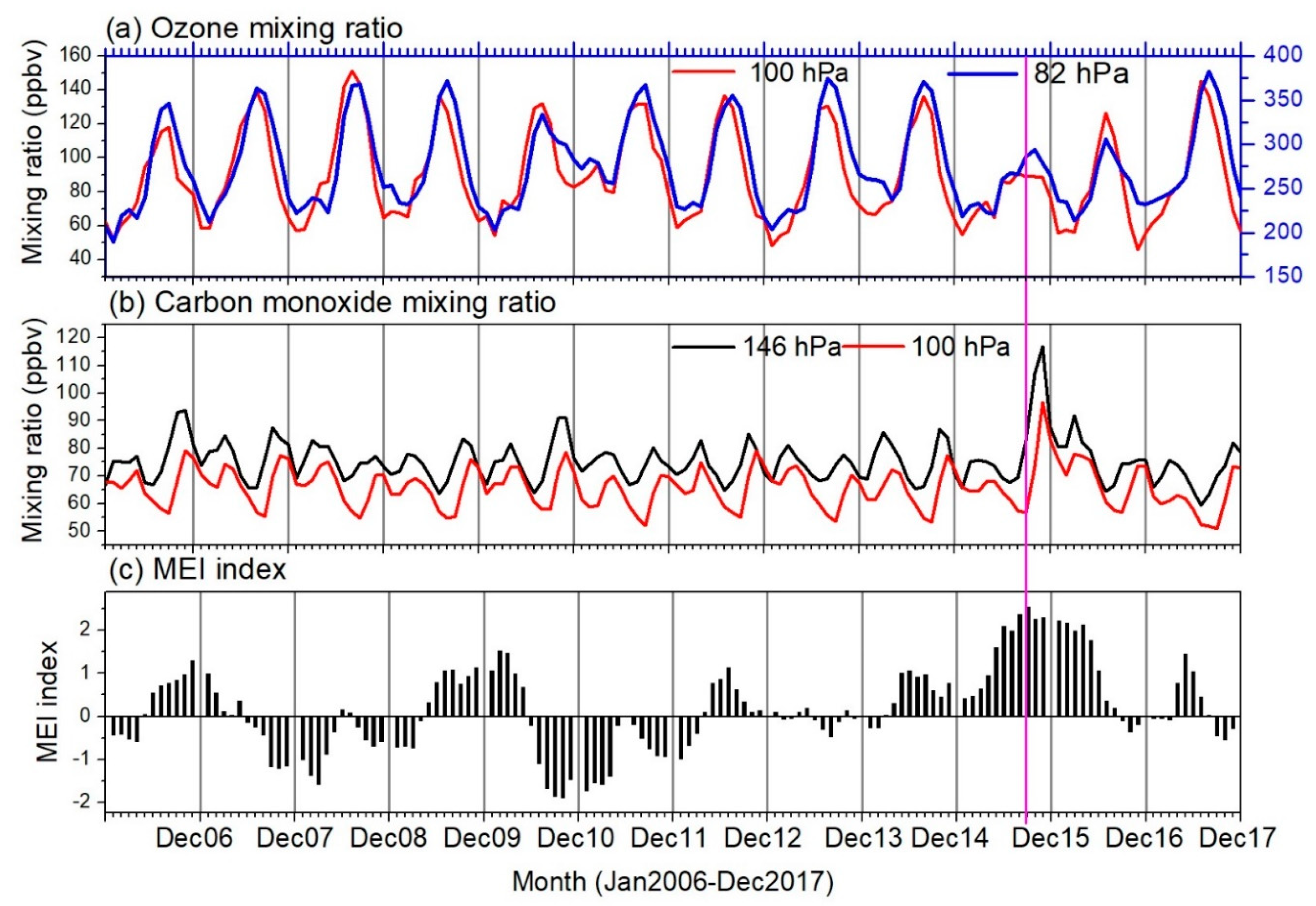
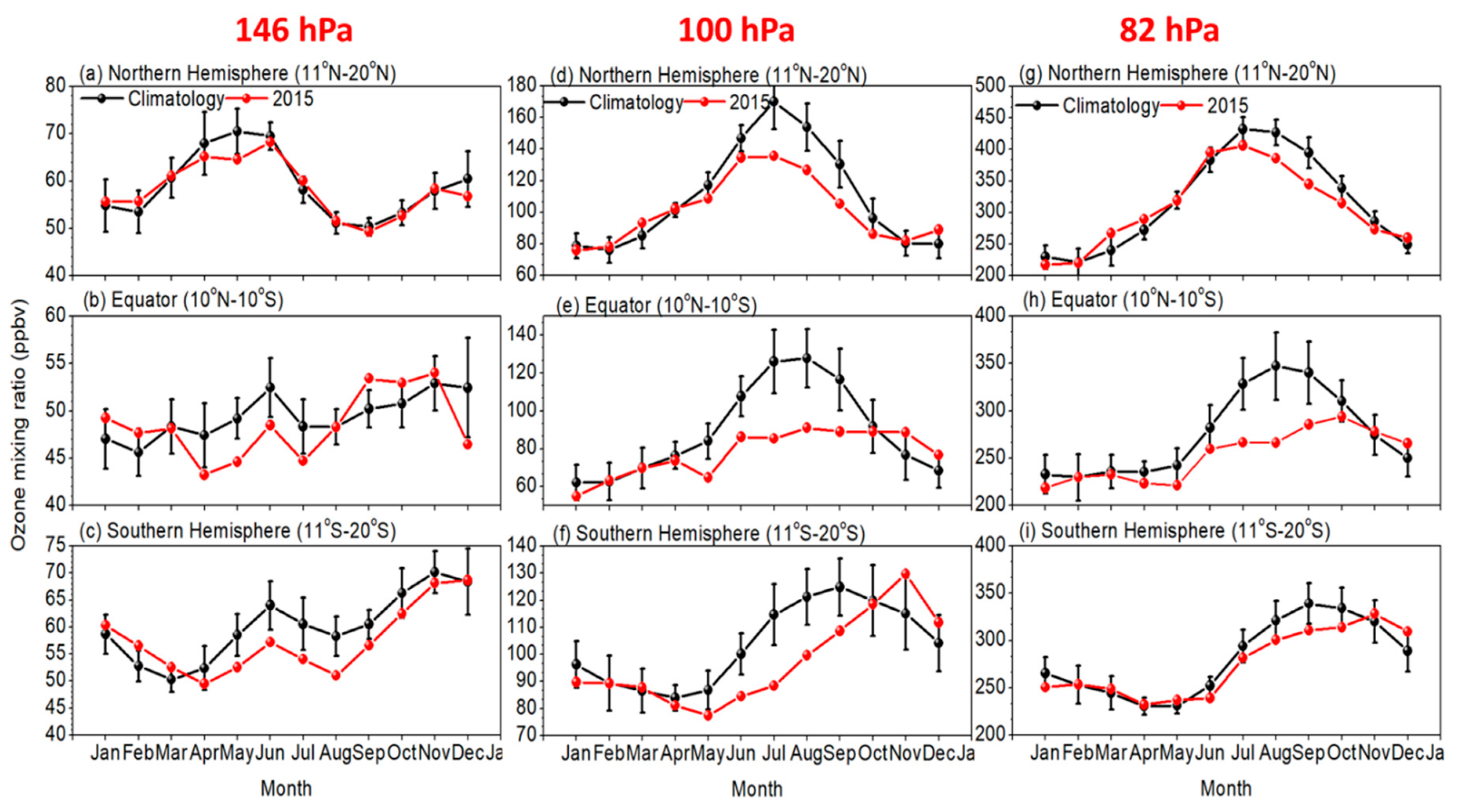
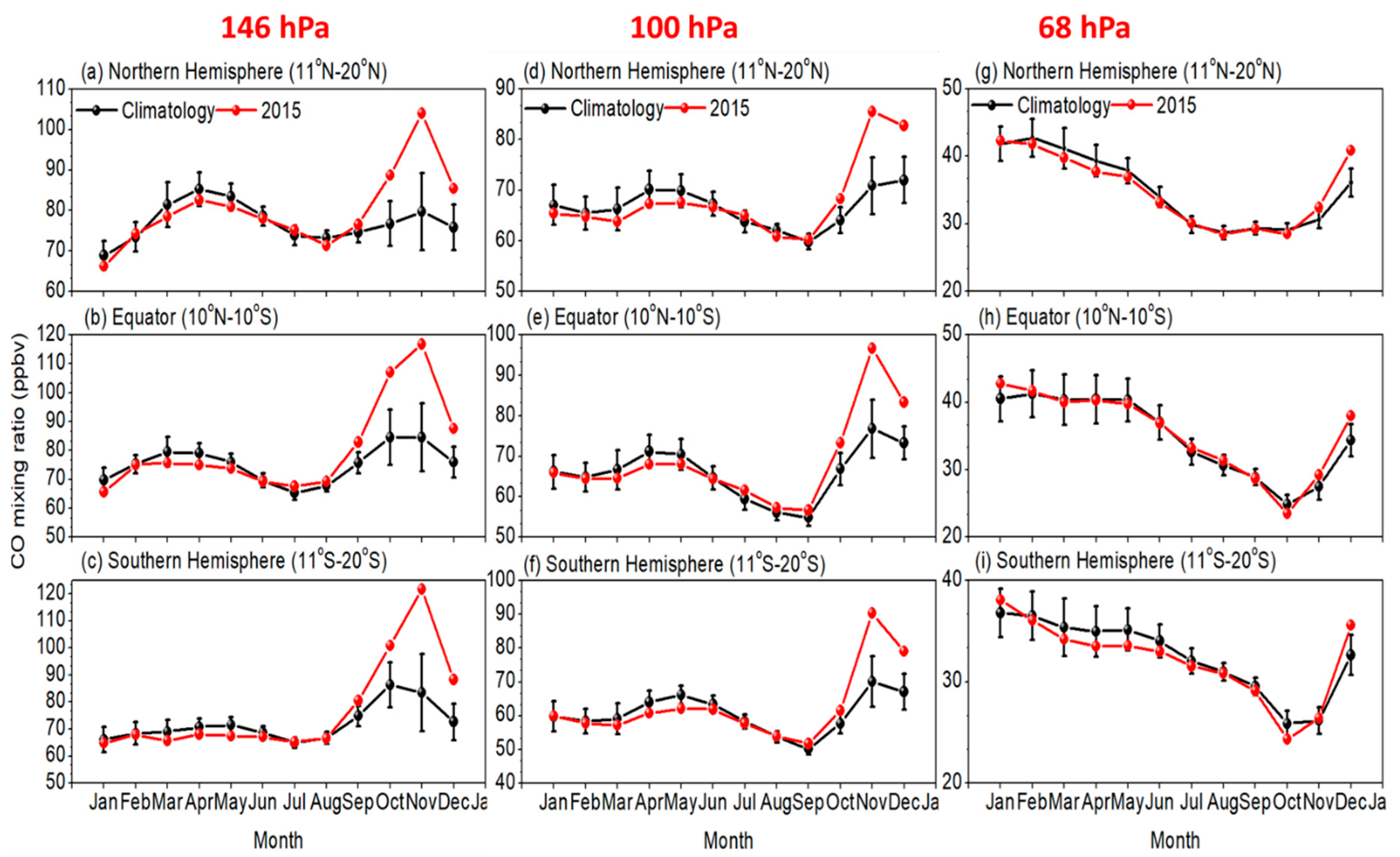
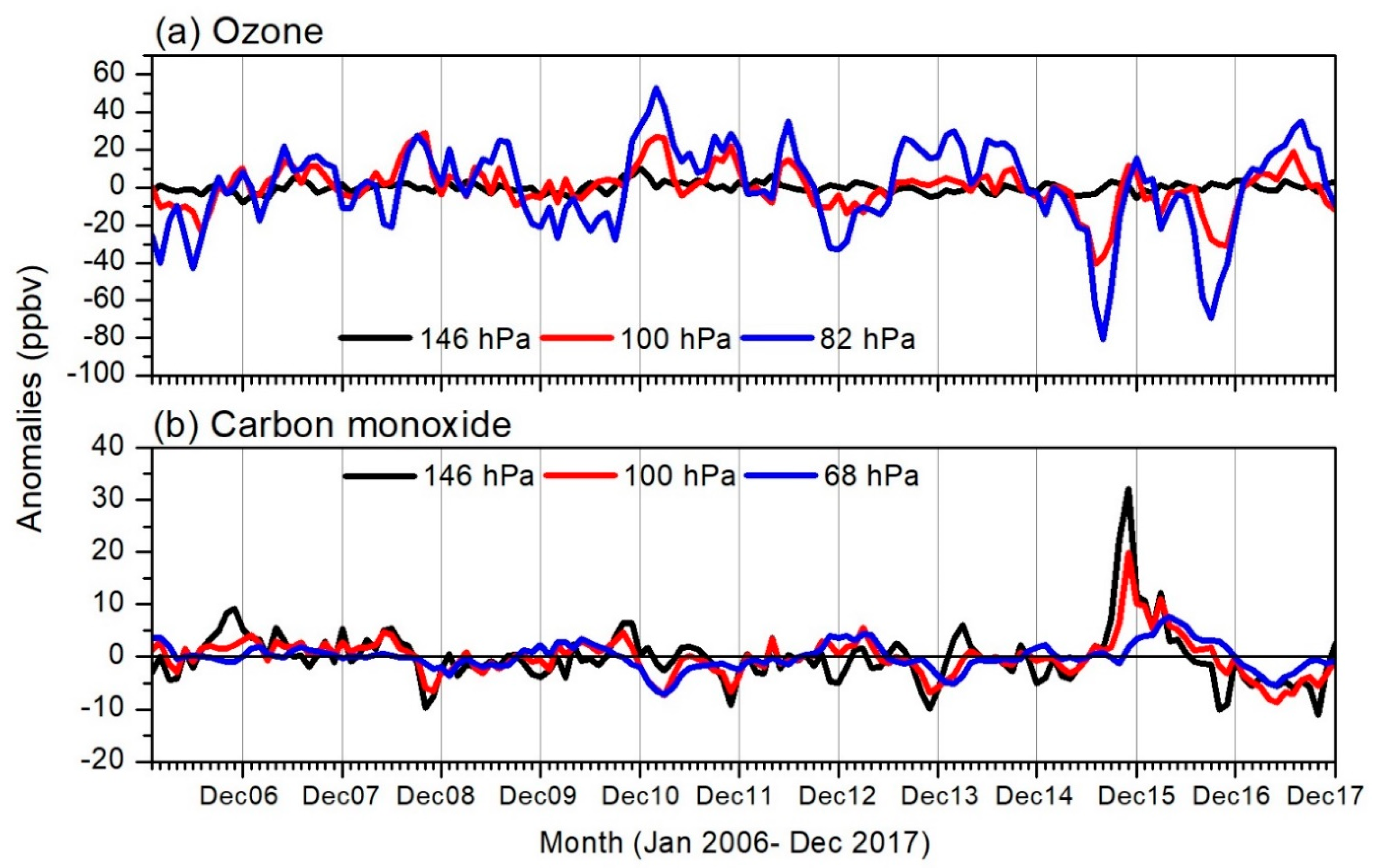



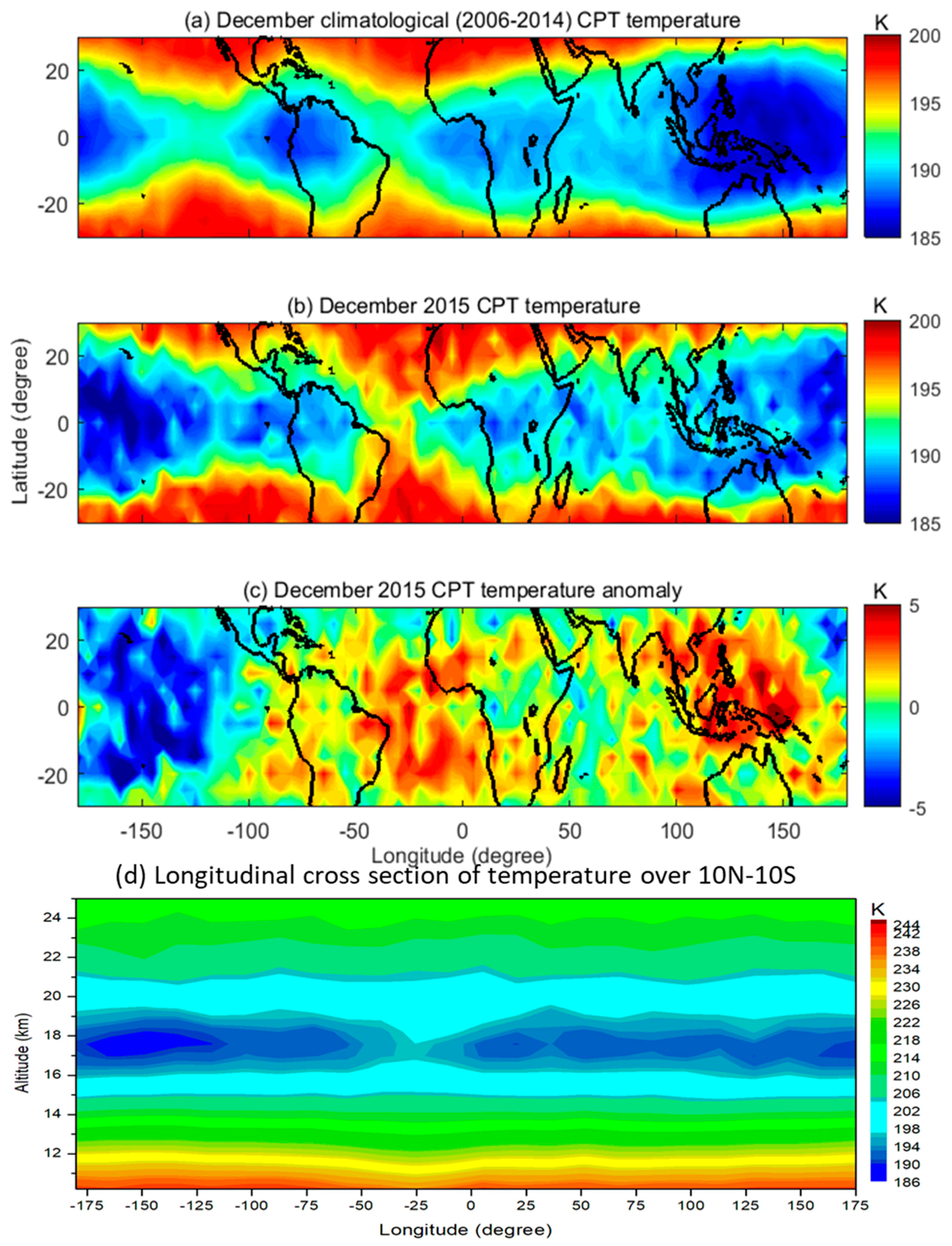

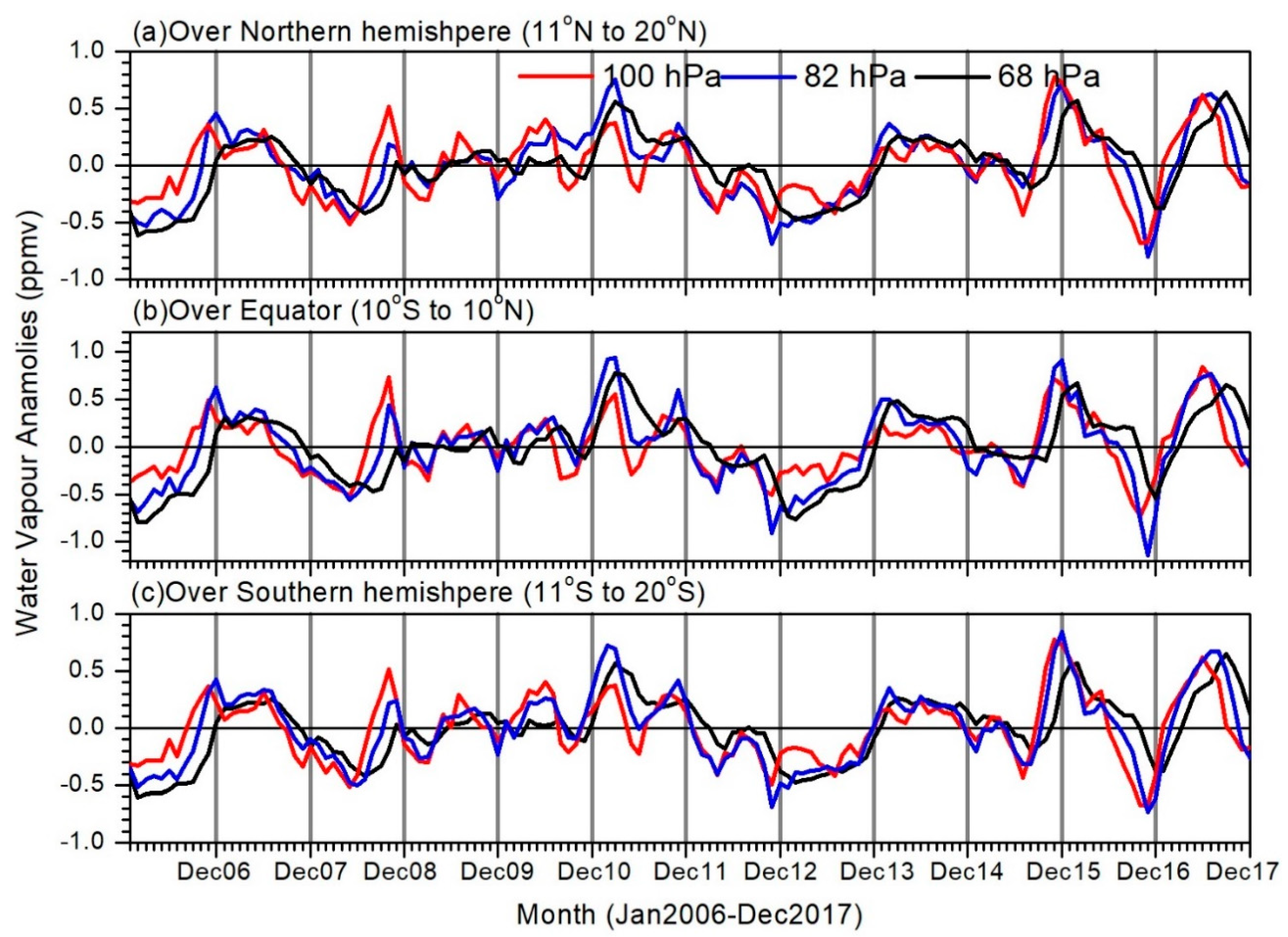

© 2019 by the authors. Licensee MDPI, Basel, Switzerland. This article is an open access article distributed under the terms and conditions of the Creative Commons Attribution (CC BY) license (http://creativecommons.org/licenses/by/4.0/).
Share and Cite
Ravindrababu, S.; Ratnam, M.V.; Basha, G.; Liou, Y.-A.; Reddy, N.N. Large Anomalies in the Tropical Upper Troposphere Lower Stratosphere (UTLS) Trace Gases Observed during the Extreme 2015–16 El Niño Event by Using Satellite Measurements. Remote Sens. 2019, 11, 687. https://doi.org/10.3390/rs11060687
Ravindrababu S, Ratnam MV, Basha G, Liou Y-A, Reddy NN. Large Anomalies in the Tropical Upper Troposphere Lower Stratosphere (UTLS) Trace Gases Observed during the Extreme 2015–16 El Niño Event by Using Satellite Measurements. Remote Sensing. 2019; 11(6):687. https://doi.org/10.3390/rs11060687
Chicago/Turabian StyleRavindrababu, S., M. Venkat Ratnam, Ghouse Basha, Yuei-An Liou, and N. Narendra Reddy. 2019. "Large Anomalies in the Tropical Upper Troposphere Lower Stratosphere (UTLS) Trace Gases Observed during the Extreme 2015–16 El Niño Event by Using Satellite Measurements" Remote Sensing 11, no. 6: 687. https://doi.org/10.3390/rs11060687
APA StyleRavindrababu, S., Ratnam, M. V., Basha, G., Liou, Y.-A., & Reddy, N. N. (2019). Large Anomalies in the Tropical Upper Troposphere Lower Stratosphere (UTLS) Trace Gases Observed during the Extreme 2015–16 El Niño Event by Using Satellite Measurements. Remote Sensing, 11(6), 687. https://doi.org/10.3390/rs11060687





